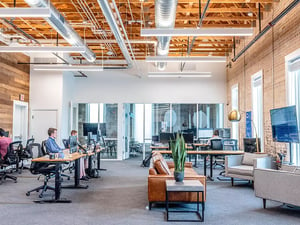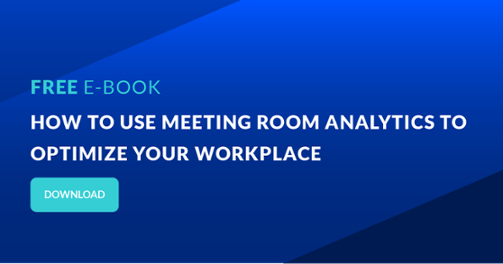Designing a workplace has historically been more about the surface-value appeal. Which type of finish is in fashion? What color scheme goes best in the conference room? What is the best furniture? While all of these factors certainly come into play when designing a workplace, did you know that having a well-planned workplace design strategy can also deliver very real benefits for your business?
In this article we will take a deeper dive into workplace design and why it is such a critical part of your overall workplace experience.
What is workplace design strategy, exactly?
The term "workplace design" in general, refers to the process of designing and organizing a working space in such a way that it optimizes a worker's performance, engagement, and satisfaction. A workplace design strategy helps foster the implementation process in such a way that the best workplace ROI may be achieved when redesigning a working area or office space. According to the EPA, the overwhelming majority of workers spend as much as 90% of their time indoors. That means they're restricted to the confines of their cubicles, offices, etc. Workplaces in the past were designed to keep individual employees focused on their task at hand without factoring in the positive effects of a workplace tailored to promote social engagement and working space autonomy.
Now more than ever, there has been a push to align workplace design with three pillars in mind that are fundamental to every business:
- A company's vision and goal
- A company's culture
- A company's employees
These three pillars are a big portion of what characterizes every business and gives them their distinct identity. A workplace design strategy takes these aspects and integrates a design concept that aligns with a company's unique fingerprint, so not only will you have a new layout, new furniture, and a new paint job, but your design will also integrate well with your organizational identity.
3 employee engagement-boosting workplace design strategies
Here at AskCody, we have put together three strategies that are among the top tried-and-true workplace design examples that are proven to boost employee engagement, retention, and overall satisfaction. Keep in mind these are not at all mutually exclusive and can be used together to formulate the best workplace design strategy possible. See below:
Strategy 1: The health and well-being promoter
As mentioned earlier, we spend the vast majority of our time indoors. This means less exposure to the psychological and physiological benefits that nature and sunlight can have on us as human beings. Since having an outdoor workplace is not always a realistic solution to the "indoor blues" problem, it should shock you that the physical setting of the working space is one of the primary factors when it comes to employee satisfaction.
A good method to optimize your workplace for health and well-being is to adhere to what is known as the WELL Being Standard. WELL has a simple measuring system that analyses seven concepts: air, water, nourishment, light, fitness, comfort, and mind. Considering all of the factors in the WELL Standard has been proven to reduce mental fatigue and increase job satisfaction.
Strategy 2: The social interaction booster
41% of the workforce is now at home, and moving from 2022 onward, 66% of businesses are considering making accommodations for a hybrid working environment. This means that employees are getting pretty used to a remote working environment. However, there are certain drawbacks to the lack of in-person communication. Since the majority of businesses are beginning to accommodate hybrid office solutions, the optimum layout of the offices is now changed. Isolating offices and cubicles are no longer as useful as they once were since employees get more than enough isolation from their home office.
Workplace design examples that promote interaction between employees have shown that it provides massive boosts in developing company culture and boosting overall morale. The role of the workplace has officially shifted into a space to build comradery and strengthen connections among workers. This means having open floor plans with couches, activities, and warm color schemes that make it more akin to a social environment rather than a place to clock in and put your head down.
Strategy 3: The home away from home
Giving employees the power of choice over where they work and when they work is an incredibly powerful workplace design strategy. When workers can control their space, they are shown to perform better, and employee retention and satisfaction tangibly improve. This workplace design began in Silicon Valley, where their goal was to have their employees want to be there, offering different types of games, lounging areas, as well as comfort-focused conference rooms, and individual offices for when they need to crunch down.
This workplace design example promotes the notion that the employee can work wherever they want within the workplace, as well as take a break and enjoy activities or grab a bite to eat, etc. This has shown to be a massively effective strategy, especially in the post-pandemic business world.
The business world is shifting more rapidly than ever before. In a time when hybrid working accommodations are being made, and record levels of employees are quitting their brick and mortar jobs in favor of at-home or hybrid alternatives, having a working environment that encourages employee engagement, satisfaction and retention are paramount for your organization. With these tried and true workplace design strategies, you're well on your way to being a part of a new age in the business workplace and up to date with the workplace design trends.
Conclusion - How to implement a workplace design strategy?
Workplace design is no longer just about aesthetics; it has become a strategic tool for businesses to enhance performance, engagement, and satisfaction. By aligning workplace design with a company's vision, culture, and employees, organizations can create a unique and effective working environment.
Strategies such as prioritizing health and well-being, fostering social interaction, and creating a home away from home for employees can significantly boost engagement, retention, and overall satisfaction. As the business world continues to evolve, it is essential for organizations to embrace these workplace design trends to stay competitive and meet the changing needs of their workforce.
So, take the plunge and invest in a well-planned workplace design strategy – your business and employees will thank you for it.




